Splint clasp prosthesis
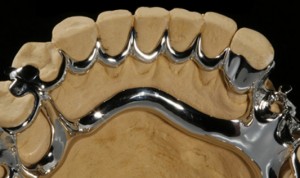
The splint clasp prosthesis is a removable structure, which is used for mobility of the dentition or individual teeth in connection with periodontal diseases.
Clasp dentures with splinting elements perform two functions: they make it possible to save loose teeth and restore lost teeth.
The splint construction is made in the form of a metal arc adjacent to the inner surface of the teeth or dentition.
The arc contains multi-link clasps, claw-shaped processes, annular clasps that fix each movable tooth.
The abutment teeth to which the structure is attached are tucked under the crowns to evenly distribute the extra chewing load from the frayed teeth to healthy teeth and alveolar processes.
The effectiveness of tooth strengthening depends on the stage of periodontal disease. The sooner treatment is started, the better the effect.
The splint clasp design for each patient is determined individually. It depends on the age, type of occlusion, the condition of the mobile and the number of lost teeth, as well as other factors.
Distinctive features
- The splint design, in comparison with a conventional clasp prosthesis, is more comfortable to use, since the size of its base is smaller and more compact.
- Due to the fact that the front of the palate is not covered by the base of the prosthesis, and the tongue remains free, the patient’s taste and diction are not changed.
- The small size of the splint prosthesis contributes to a faster adaptation to the design.
- It does not cause atrophic changes in bone tissue and gums, and therefore there is no appearance of discomfort with the further use of the prosthesis.
- Structural features of the structure minimize the likelihood of breakdown.
Indications
Clasp prosthetics as splinting shown in the following cases:
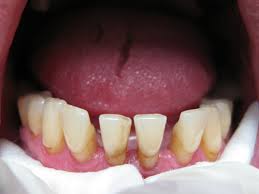
- The absence of at least three teeth in the dentition, in the absence of support on one side.
- Disease of the tissues surrounding the teeth, accompanied by gingival bleeding.
- The absence of one tooth.
- The location of the teeth in the wrong position.
- The presence of bruxism and deep bite.
- With defects in the dentition with tooth displacement.
- Exposure of tooth roots.
- Pronounced gingival pockets.
- Periodontal disease, accompanied by loosening of the teeth, in order to fix them and redistribute the load.
When tooth mobility occurs during periodontitis, the atrophic processes of bone tissue are accelerated, which leads to their even loosening. If the disease is not treated, then the process becomes uncontrollable.
Under the influence of loads, loosened teeth bend to the sides, change their position, diverge fan-shaped.To stop the progression of the process, they need to be splinted.
For the use of clasp structures, a prerequisite is the presence of abutment teeth.
Contraindications
Installation of splint clasp prostheses is contraindicated in the case of:

- Lack of proper oral hygiene.
- The presence of pregnancy.
- Condition after radiation therapy.
- Acute inflammatory processes of the oral cavity.
- Oncological diseases.
- Mental disorders.
- Exacerbations of heart and vascular diseases.
- Respiratory diseases in the acute stage.
- Allergic reactions to metal.
- Bone disease.
It will not work to install the splinting structure in the following cases:
- In the presence of pathology of supporting teeth intended for fixation with the help of clasps.
- If the supporting teeth do not have a sufficient height.
- With a deep bite.
- The presence of severe atrophy of the alveolar processes.
- Lack of mucosal compliance at the site of missing teeth.
- Intolerances of a removable prosthesis.
- With insufficient depth of the bottom of the oral cavity.
- Addiction or alcoholism.
Video: Clasp prosthesis
Prices
The cost of splinting clasp prostheses is higher than laminar ones. This is due to the fact that splinting structures are made longer.
In comparison, with other designs they are more practical and durable, and they also get used to them faster.
The high price of arch prostheses with splinting action is fully paid for by the fact that they restore the anatomical and physiological characteristics of the oral cavity and teeth.
| Type of prosthesis | Price, rub) |
| Clasp prosthesis with clasps | 39500 |
| Splint clasp | 39500 |
| Clasp prosthesis with locks | 72000 |
Reviews
Clasp splint constructions can solve the problem of preserving and strengthening loose teeth.
When choosing a prosthesis, it is necessary to understand that such designs also help restore lost teeth.
Here's what patients who use splinted dentures say:
- With age, the teeth became loose and their gradual loss began. I thought I had to say goodbye to all my teeth. He went to the clinic, where they installed a splint clasp prosthesis. The result inspired me. In place of the missing teeth, artificial and real ones became smoother and hardly stagger.
- I have been suffering from periodontal disease for about ten years. She splinted five lower frontal teeth two years ago. I got used to the prosthesis for a long time. The convenience is that it does not need to be removed at night, but only for hygiene measures. Teeth almost do not stagger.
- With age, there has been a large loss of teeth. Three years ago I turned to a dental clinic, where they did the splinting with removable dentures on the locks. I got used to them for two months. Now I don’t notice them. As if - my family.
- A year ago, I installed a clasp prosthesis and I'm very sorry. On the first day of use, the gums were very painful, after which I felt for a long time that I had a large piece of metal in my mouth. A front ache appeared in the front teeth. I turned to the dentist, who said that this is normal. Some people get used to the design and six months. Now I’m almost used to it, but sometimes I still feel discomfort.
- I have been suffering from periodontitis for a long time. In the last two years, the teeth are loosened and even fall out. The dentist put a splint prosthesis. I was satisfied with the result, because there is something to chew on and the speech defect, which was due to the absence of several teeth, disappeared.
- Some teeth became loose with age. Set clasp construction effect. The prosthesis is very comfortable to use. It does not interfere with eating and talking.
- Several teeth were missing on the lower jaw, and some of the others were very mobile. Three years ago, he installed a splint prosthesis that helped restore missing teeth and strengthen cranked teeth. Teeth no longer fall out - very pleased with the result.
Before and after photos
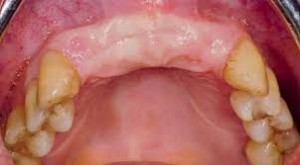 |
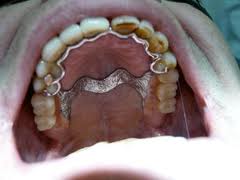 |
 |
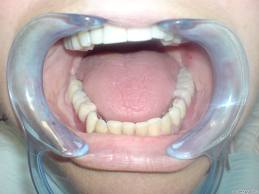 |
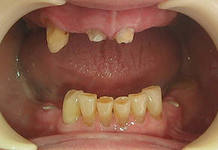 |
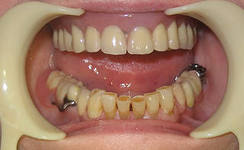 |
Video: “A fundamentally new clasp prosthesis”